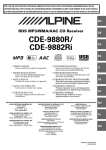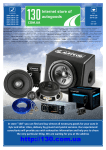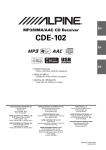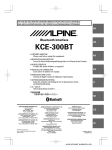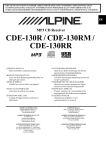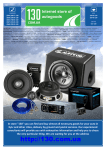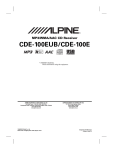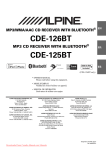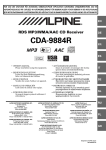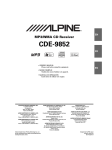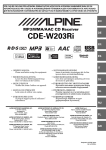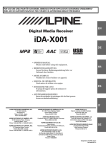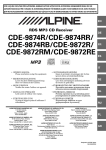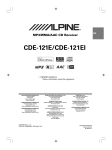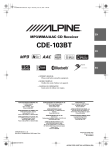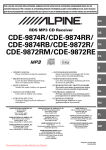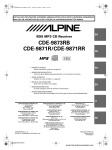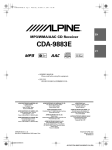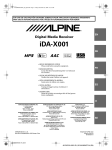Download Alpine CDE-9873 Microphone User Manual
Transcript
R EN MP3/WMA/AAC CD Receiver CDE-9873 FR ES • OWNER’S MANUAL Please read before using this equipment. • MODE D’EMPLOI Veuillez lire avant d’utiliser cet appareil. • MANUAL DE OPERACIÓN Léalo antes de utilizar este equipo. ALPINE ELECTRONICS MARKETING, INC. 1-1-8 Nishi Gotanda, Shinagawa-ku, Tokyo 141-0031, Japan Phone 03-5496-8231 ALPINE ELECTRONICS OF AMERICA, INC. 19145 Gramercy Place, Torrance, California 90501, U.S.A. Phone 1-800-ALPINE-1 (1-800-257-4631) ALPINE ELECTRONICS OF CANADA, INC. 777 Supertest Road, Toronto, Ontario M3J 2M9, Canada Phone 1-800-ALPINE-1 (1-800-257-4631) YAMAGATA (Wuxi) Co., Ltd. Block 28-25,Changjiang Nanlu, WND, jiangsu, China ALPINE ELECTRONICS OF AUSTRALIA PTY. LTD. 161-165 Princes Highway, Hallam Victoria 3803, Australia Phone 03-8787-1200 ALPINE ITALIA S.p.A. Viale C. Colombo 8, 20090 Trezzano Sul Naviglio (MI), Italy Phone 02-484781 ALPINE ELECTRONICS GmbH Frankfurter Ring 117, 80807 München, Germany Phone 089-32 42 640 ALPINE ELECTRONICS DE ESPAÑA, S.A. Portal de Gamarra 36, Pabellón, 32 01013 Vitoria (Alava)-APDO 133, Spain Phone 945-283588 ALPINE ELECTRONICS OF U.K. LTD. Alpine House Fletchamstead Highway, Coventry CV4 9TW, U.K. Phone 0870-33 33 763 ALPINE ELECTRONICS (BENELUX) GmbH Leuvensesteenweg 510-B6, 1930 Zaventem, Belgium Phone 02-725-13 15 ALPINE ELECTRONICS FRANCE S.A.R.L. (RCS PONTOISE B 338 101 280) 98, Rue de la Belle Etoile, Z.I. Paris Nord Il, B.P. 50016, 95945 Roissy Charles de Gaulle Cedex, France Phone 01-48638989 Designed by ALPINE Japan Printed in China (Y) 68-05946Z84-A ENGLISH Contents Other Functions Displaying the Text ......................................... 14 Operating Instructions Displaying Time ............................................. 14 SETUP WARNING WARNING ................................................. 3 CAUTION .................................................. 3 PRECAUTIONS ........................................ 3 Getting Started Accessory List .................................................. 6 Sound Customizing Subwoofer On and Off .....................................15 Setting the Subwoofer System .........................15 Visual Customizing Dimmer Control ...............................................15 Scroll Type Setting ...........................................15 Scroll Setting (TEXT SCR) ..............................16 Demonstration ..................................................16 Turning Power On and Off ............................... 6 Detaching and Attaching the Front Panel ........ 6 Initial System Start-Up ..................................... 6 Adjusting Volume ............................................. 6 Lowering Volume Quickly ............................... 7 Setting Time ..................................................... 7 Radio MP3/WMA/AAC Playing MP3/WMA/AAC Data (Play Mode) ..................................................16 External Device Connecting to an External Amplifier (POWER IC) .................................................16 iPod® (Optional) Listening to Radio ............................................ 7 Playback .......................................................... 17 Presetting Stations Manually ............................ 8 Searching for a desired Song .......................... 17 Presetting Stations Automatically .................... 8 Quick Search ................................................... 18 Tuning to Preset Stations .................................. 8 Direct Search Function ................................... 18 CD/MP3/WMA/AAC Playback ........................................................... 8 Repeat Play ....................................................... 9 M.I.X. (Random Play) ...................................... 9 Searching from CD Text .................................. 9 File/Folder Name Search (concerning MP3/WMA/AAC) .................. 10 Quick Search .................................................. 10 Select Playlist/Artist/Album/Podcast/Genre/ Composer .................................................... 18 Random Play Shuffle (M.I.X.) ........................ 19 Repeat Play ..................................................... 19 Displaying the Text ......................................... 19 Information In Case of Difficulty ....................................... 20 Specifications .................................................. 22 About MP3/WMA/AAC ................................ 10 Sound Setting Adjusting Bass/Treble/Balance (Between Left and Right)/Fader (Between Front and Rear)/ Defeat .......................................................... 12 Setting the Bass Control ................................. 12 Setting the Treble Control .............................. 13 Adjusting the High Pass Filter ....................... 13 Turning Loudness On/Off .............................. 13 1-EN Installation and Connections Warning .................................................. 23 Caution ................................................... 23 Precautions ............................................ 23 Installation ...................................................... 24 Connections .................................................... 26 LIMITED WARRANTY 2-EN Operating Instructions WARNING DO NOT PLACE HANDS, FINGERS OR FOREIGN OBJECTS IN INSERTION SLOTS OR GAPS. Doing so may result in personal injury or damage to the product. WARNING This symbol means important instructions. Failure to heed them can result in serious injury or death. DO NOT OPERATE ANY FUNCTION THAT TAKES YOUR ATTENTION AWAY FROM SAFELY DRIVING YOUR VEHICLE. Any function that requires your prolonged attention should only be performed after coming to a complete stop. Always stop the vehicle in a safe location before performing these functions. Failure to do so may result in an accident. KEEP THE VOLUME AT A LEVEL WHERE YOU CAN STILL HEAR OUTSIDE NOISES WHILE DRIVING. Excessive volume levels that obscure sounds such as emergency vehicle sirens or road warning signals (train crossings, etc.) can be dangerous and may result in an accident. LISTENING AT LOUD VOLUME LEVELS IN A CAR MAY ALSO CAUSE HEARING DAMAGE. CAUTION This symbol means important instructions. Failure to heed them can result in injury or material property damage. HALT USE IMMEDIATELY IF A PROBLEM APPEARS. Failure to do so may cause personal injury or damage to the product. Return it to your authorized Alpine dealer or the nearest Alpine Service Center for repairing. PRECAUTIONS Product Cleaning Use a soft dry cloth for periodic cleaning of the product. For more severe stains, please dampen the cloth with water only. Anything else has the chance of dissolving the paint or damaging the plastic. Temperature MINIMIZE DISPLAY VIEWING WHILE DRIVING. Be sure the temperature inside the vehicle is between +60°C (+140°F) and –10°C (+14°F) before turning your unit on. Viewing the display may distract the driver from looking ahead of the vehicle and cause an accident. Moisture Condensation Doing so may result in an accident, fire or electric shock. You may notice the CD playback sound wavering due to condensation. If this happens, remove the disc from the player and wait about an hour for the moisture to evaporate. USE ONLY IN CARS WITH A 12 VOLT NEGATIVE GROUND. Damaged Disc (Check with your dealer if you are not sure.) Failure to do so may result in fire, etc. Do not attempt to play cracked, warped, or damaged discs. Playing a bad disc could severely damage the playback mechanism. KEEP SMALL OBJECTS SUCH AS BATTERIES OUT OF THE REACH OF CHILDREN. Maintenance DO NOT DISASSEMBLE OR ALTER. Swallowing them may result in serious injury. If swallowed, consult a physician immediately. If you have problems, do not attempt to repair the unit yourself. Return it to your Alpine dealer or the nearest Alpine Service Station for servicing. USE THE CORRECT AMPERE RATING WHEN REPLACING FUSES. Failure to do so may result in fire or electric shock. DO NOT BLOCK VENTS OR RADIATOR PANELS. Doing so may cause heat to build up inside and may result in fire. USE THIS PRODUCT FOR MOBILE 12V APPLICATIONS. Use for other than its designed application may result in fire, electric shock or other injury. 3-EN Never Attempt the Following Installation Location Do not grip or pull out the disc while it is being pulled back into the player by the automatic reloading mechanism. Do not attempt to insert a disc into the unit when the unit power is off. Make sure this unit will not be installed in a location subjected to: • • • • Direct sun and heat High humidity and water Excessive dust Excessive vibrations Correct Handling Do not drop the disc while handling. Hold the disc so you will not leave fingerprints on the surface. Do not affix tape, paper, or gummed labels to the disc. Do not write on the disc. CORRECT Inserting Discs Your player accepts only one disc at a time for playback. Do not attempt to load more than one disc. Make sure the label side is facing up when you insert the disc. “ERROR” will be displayed on your player if you insert a disc incorrectly. If “ERROR” continues to be displayed even though the disc has been inserted correctly, push the RESET switch with a pointed object such as a ballpoint pen. Playing a disc while driving on a very bumpy road may result in skips, but this will not scratch the disc or damage the player. To prevent the CD from jamming, “ERROR” is displayed if discs with irregular surfaces are inserted or if discs are inserted incorrectly. When a new disc is ejected immediately after initial loading, use your finger to feel around the inside of the center hole and outside edge of the disc. If you feel any small bumps or irregularities, this could inhibit proper loading of the disc. To remove the bumps, rub the inside edge of the hole and outside edge of the disc with a ballpoint pen or other such instrument, then insert the disc again. Bumps Fingerprints, dust, or soil on the surface of the disc could cause the CD player to skip. For routine cleaning, wipe the playing surface with a clean, soft cloth from the center of the disc to the outer edge. If the surface is heavily soiled, dampen a clean, soft cloth in a solution of mild neutral detergent before cleaning the disc. Center Hole New Disc Outside (Bumps) Irregular Shaped Discs Be sure to use round shape discs only for this unit and never use any special shape discs. Use of special shape discs may cause damage to the mechanism. Disc Accessories There are various accessories available on the market for protecting the disc surface and improving sound quality. However, most of them will influence the thickness and/or diameter of the disc. Using such accessories can cause the disc to be out of standard specifications and may create operational problems. We recommend not using these accessories on discs played in Alpine CD players. Transparent Sheet 4-EN CORRECT Disc Cleaning New Discs Center Hole INCORRECT Disc Stabilizer On handling Compact Discs (CD/CD-R/CD-RW) • • • • • • Do not touch the surface. Do not expose the disc to direct sunlight. Do not affix stickers or labels. Clean the disc when it is dusty. Make sure that there are no bumps around the disc. Do not use commercially available disc accessories. Do not leave the disc in the car or the unit for a long time. Never expose the disc to direct sunlight. Heat and humidity may damage the CD and you may not be able to play it again. To customers using CD-R/CD-RW • If a CD-R/CD-RW cannot be played back, make sure the last recording session was closed (finalized). • Finalize the CD-R/CD-RW if necessary, and attempt playback again. About media that can be played Use only compact discs with the label side showing the CD logo marks below. If you use unspecified compact discs, correct performance cannot be guaranteed. You can play CD-Rs (CD-Recordables)/CD-RWs (CDReWritables) which have been recorded only on audio devices. You can also play CD-Rs/CD-RWs containing MP3/WMA/AAC formatted audio files. • Some of the following CDs may not play on this unit: Flawed CDs, CDs with fingerprints, CDs exposed to extreme temperatures or sunlight (e.g., left in the car or this unit), CDs recorded under unstable conditions, CDs on which a recording failed or a re-recording was attempted, copy-protected CDs which do not conform to the audio CD industry standard. • Use discs with MP3/WMA/AAC files written in a format compatible with this unit. For details, see pages 10-11. • ROM data other than audio files contained in a disc will not produce sound when played back. • Windows Media and the Windows logo are trademarks, or registered trademarks of Microsoft Corporation in the United States and/or other countries. • Apple, the Apple logo, iPod and iTunes are trademarks of Apple Computer, Inc., registered in the U.S. and other countries. • “MPEG Layer-3 audio coding technology licensed from Fraunhofer IIS and Thomson.” • “Supply of this product only conveys a license for private, non-commercial use and does not convey a license nor imply any right to use this product in any commercial (i.e. revenuegeneration) real time broadcasting (terrestrial, satellite, cable and/or any other media), broadcasting/streaming via internet, intranets and/or other networks or in other electronic content distribution systems, such as pay-audio or audio-on-demand applications. An independent license for such use is required. For details, please visit http://www. mp3licensing.com” 5-EN Getting Started /ENT (MUTE)/ RTN SOURCE/ (Release) A.SEL/SETUP Accessory List • • • • • • • Head unit ............................................................................1 Power cable........................................................................1 Mounting sleeve.................................................................1 Carrying case .....................................................................1 Bracket key.........................................................................2 Screw (M5 × 8)....................................................................4 Owner’s Manual .......................................................... 1 set Turning Power On and Off Press SOURCE/ 1 2 Rotary encoder / Attaching Insert the right side of the front panel into the main unit. Align the groove on the front panel with the projections on the main unit. Push the left side of the front panel until it locks firmly into the main unit. • Before attaching the front panel, make sure that there is no dirt or dust on the connector terminals and no foreign object between the front panel and the main unit. • Attach the front panel carefully, holding the sides of the front panel to avoid pushing buttons by mistake. Initial System Start-Up Be sure to press the RESET switch when using the unit for the first time, after changing the car battery, etc. 1 2 3 Turn off the unit power. Remove the detachable front panel. Press RESET with a ballpoint pen or similar pointed object. to turn on the unit. • The unit can be turned on by pressing any other button except TITLE, and (Release). Press and hold SOURCE/ turn off the unit. 1 for at least 2 seconds to • The first time power is turned on, the volume will start from level 12. RESET switch Detaching and Attaching the Front Panel Adjusting Volume Detaching 1 2 3 Turn off the unit power. Press (Release) at the lower left side until the front panel pops out. Grasp the left side of the front panel and pull it out. • The front panel may become hot in normal usage (especially the connector terminals on the back of the front panel). This is not a malfunction. • To protect the front panel, place it in the supplied carrying case. • When detaching the front panel, do not apply excessive force as it may result in malfunction. 6-EN Turn the Rotary encoder until the desired sound is obtained. Lowering Volume Quickly Radio Activating the Audio Mute function will instantly lower the volume level by 20 dB. Press (MUTE)/RTN to activate the MUTE mode. TUNE/A.ME SOURCE/ BAND The audio level will decrease by about 20 dB. Pressing (MUTE)/RTN again will bring the audio back to its previous level. Setting Time 1 2 Turn the Rotary encoder to select the CLOCK ADJ mode, and then press / /ENT. The time indication will blink. 3 4 5 6 Preset buttons (1 through 6) Press and hold A.SEL/SETUP for at least 2 seconds to activate the SETUP mode. Turn the Rotary encoder to adjust the hours while the time indication is blinking. When the hour has been adjusted, press / Listening to Radio 1 2 /ENT. Press SOURCE/ Press BAND repeatedly until the desired radio band is displayed. F1 (FM1) Turn the Rotary encoder to adjust the minutes while the time indication is blinking. 3 to select TUNER mode. F2 (FM2) AM F1 (FM1) Press TUNE/A.ME to select the tuning mode. DX SEEK (Distance mode) SEEK (Local mode) OFF (Manual mode) DX SEEK Press and hold A.SEL/SETUP for at least 2 seconds to return to normal mode. • The initial mode is Distance mode. • To synchronize the clock to another clock/watch or radio time announcement, press and hold / /ENT for at least 2 seconds after setting the “hour.” Minutes will reset to “00”. If the display shows over “30” minutes when you do this, the time will advance one hour. • Pressing /RTN will return to the previous mode. • If no operation is performed for 60 seconds, the unit will return to normal mode automatically. Distance mode: Both strong and weak stations will be automatically tuned in (Automatic Seek Tuning). Local mode: Only strong stations will be automatically tuned in (Automatic Seek Tuning). Manual mode: The frequency is manually tuned in steps (Manual tuning). 4 Press Holding down continuously. or to tune in the desired station. or will change the frequency 7-EN Presetting Stations Manually 1 2 CD/MP3/WMA/AAC Select the radio band and tune in a desired radio station you wish to store in the preset memory. /ESC Rotary encoder / / SOURCE/ ENT Press and hold, for at least 2 seconds, any one of the preset buttons (1 through 6) into which you wish to store the station. The selected station is stored. The display shows the band, preset number and station frequency memorized. • A total of 18 stations can be stored in the preset memory (6 stations for each band; FM1, FM2 and AM). • If you store a station in a preset memory which already has a station, the current station will be cleared and replaced with the new station. 1 /RTN 2 4 5 TITLE Presetting Stations Automatically 1 2 Press BAND repeatedly until the desired radio band is displayed. Press and hold TUNE/A.ME for at least 2 seconds. Playback 1 The frequency on the display continues to change while the automatic memory is in progress. The tuner will automatically seek and store 6 strong stations in the selected band. They will be stored into preset buttons 1 to 6 in order of signal strength. When the automatic memory has been completed, the tuner goes to the station stored in preset location No.1. • If no stations are stored, the tuner will return to the original station you were listening to before the auto memory procedure began. 2 The disc will be pulled into the unit automatically, and the “DISC IN” indicator lights up . When a disc is already inserted, press SOURCE/ switch to the DISC mode. Tuning to Preset Stations 1 Insert a disc with the label side facing up. The mode will change every time the button is pressed. TUNER Press BAND repeatedly until the desired band is displayed. Press any one of the station preset buttons (1 through 6) that has your desired radio station in memory. The display shows the band, preset number and frequency of the station selected. DISC iPod* TUNER * Only when the iPod is connected. 2 While playing back MP3/WMA/AAC, press 1 2 to select the desired folder. Pressing and holding 1 continuously. 3 Press or or Fast backward: Press and hold to select the desired track (file). . Advancing to the beginning of the next track (file): Press . Fast forward: Press and hold 4 or 2 will change folders Returning to the beginning of the current track (file): Press . 8-EN to . To pause playback, press / /ENT. Pressing / /ENT again will resume playback. 5 To eject the disc, press . • Do not remove a CD during its eject cycle. Do not load more than one disc at a time. A malfunction may result from doing either. • If the CD does not eject, press and hold for at least 2 seconds. • The “DISC IN” indicator lights up when a disc is inserted. • The CD-player can play discs containing audio data, MP3 data, WMA data and AAC data. • WMA format files that are protected by DRM (Digital Rights Management), AAC format files that have been purchased from iTunes Music Store and files that are copy-protected (copyright protection) cannot be played back on this unit. • The track display for MP3/WMA/AAC data playback is the file numbers recorded on the disc. • The playback time may not be correctly displayed when a VBR (Variable Bit Rate) recorded file is played back. M.I.X. (Random Play) Press 5 in the play or pause mode. The tracks (files) on the disc will be played back in random sequence. To cancel M.I.X. play, press 5 again. CD mode : : The tracks are played back in random sequence. MP3/WMA/AAC Play Display The folder number and file number will be displayed as described below. MP3/WMA/AAC mode : : Only files in a folder are played back in random sequence. F101 T103 : The files are played back in random sequence. Folder number display File number display • Press TITLE to switch the display. See “Displaying the Text” (page 14) for information about display switching. Searching from CD Text Repeat Play 4 to play back repeatedly the track being Press played. The track (file) will be played repeatedly. Press 4 again and select off to deactivate repeat play. CD mode : : Only a track is repeatedly played back. Tracks can be searched and played by using the CD text on the disc. In the case of discs that do not support text, searches can be made by using the track numbers. 1 2 Press /ESC during play. This will set the search mode. Turn the Rotary encoder to select the desired track, and then press / /ENT. This will play the selected track. • Press and hold /ESC for at least 2 seconds in the search mode to cancel. Or, the search mode is canceled if no operation is performed for 10 seconds. • CD text search cannot be made during M.I.X. play. MP3/WMA/AAC mode : : Only a file is repeatedly played back. : Only files in a folder are repeatedly played back. 9-EN File/Folder Name Search (concerning MP3/WMA/AAC) About MP3/WMA/AAC Folder and file names may be searched and displayed during playback. 1 2 During MP3/WMA/AAC playback, press activate the search mode. /ESC to Turn the Rotary encoder to select Folder Name Search mode or File Name Search mode, and then press / /ENT. Folder Name Search mode 3 4 Turn the Rotary encoder to select the desired folder. Press and hold / /ENT for at least 2 seconds to play back the first file in the selected folder. • Press and hold /ESC for at least 2 seconds in the search mode to cancel. Or, the search mode is canceled if no operation is performed for 10 seconds. • To search for files in the Folder Name Search mode, press / /ENT. Files in the folder may be searched. • Press /RTN to exit Folder Name Search mode in step 3 in order to select File Name Search mode. • The root folder is displayed as “ ”. • Folder Name Search cannot be made during M.I.X. play. File Name Search mode 3 4 5 Press 1 or 2 to select another Folder. Select the desired file by turning the Rotary encoder. Press / /ENT to play back the selected file. • Press and hold /ESC for at least 2 seconds in the search mode to cancel. Or, the search mode is canceled if no operation is performed for 10 seconds. • Press /RTN in the search mode to return to the previous mode. • File Name search cannot be made during M.I.X. play. Quick Search You can search for tracks (files). 1 2 Press and hold /ESC for at least 2 seconds in the CD/MP3/WMA/AAC mode to activate Quick Search mode. Turn the Rotary encoder to select a desired track (file). The selected track is played back immediately. • Press and hold /ESC for at least 2 seconds in the search mode to cancel. Or, the search mode is canceled if no operation is performed for 10 seconds. 10-EN CAUTION Except for private use, duplicating audio data (including MP3/WMA/AAC data) or distributing, transferring, or copying it, whether for free or for a fee, without permission of the copyright holder is strictly prohibited by the Copyright Act and by international treaty. What is MP3? MP3, whose official name is “MPEG-1 Audio Layer 3,” is a compression standard prescribed by the ISO, the International Standardization Organization and MPEG which is a joint activity institution of the IEC. MP3 files contain compressed audio data. MP3 encoding is capable of compressing audio data at extremely high ratios, reducing the size of music files to as much as one-tenth their original size. This is achieved while still maintaining near CD quality. The MP3 format realizes such high compression ratios by eliminating the sounds that are either inaudible to the human ear or masked by other sounds. What is WMA? WMA, or “Windows Media™ Audio,” is compressed audio data. WMA is similar to MP3 audio data and can achieve CD quality sound with small file sizes. What is AAC? AAC is the abbreviation for “Advanced Audio Coding,” and is a basic format of audio compression used by MPEG2 or MPEG4. Method for creating MP3/WMA/AAC files Audio data is compressed using software with MP3/WMA/AAC codecs. For details on creating MP3/WMA/AAC files, refer to the user’s manual for that software. MP3/WMA/AAC files that are playable on this device have the file extensions “mp3” / “wma” / “m4a.” Files with no extension cannot be played back (WMA ver. 7.1 , 8 and 9 are supported). Protected files are not supported, neither are raw AAC files (using the “.aac” extension). There are many different versions of the AAC format. Confirm that the software being used conforms to the acceptable formats listed above. It’s possible that the format may be unplayable even though the extension is valid. Playback of AAC files encoded by iTunes version 6.0 or earlier is supported. Supported playback sampling rates and bit rates Order of files Files are played back in the order that the writing software writes them to the disc. Therefore, the playback order may not be what is expected. Verify the writing order in the software’s documentation. The playback order of the folders and files is as follows. MP3 Sampling rates: 48 kHz, 44.1 kHz, 32 kHz, 24 kHz, 22.05 kHz, 16 kHz, 12 kHz, 11.025 kHz, 8 kHz Bit rates: 8 - 320 kbps WMA Sampling rates: 48 kHz, 44.1 kHz, 32 kHz Bit rates: 48 - 192 kbps Root folder AAC Sampling rates: 48 kHz, 44.1 kHz, 32 kHz, 24 kHz, 22.05 kHz, 16 kHz, 12 kHz, 11.025 kHz, 8 kHz Bit rates: 16 - 320 kbps This device may not play back correctly depending on sampling rates. ID3 tags/WMA tags This device supports ID3 tag v1 and v2, and WMA tag. If tag data is in an MP3/WMA/AAC file, this device can display the title (track title), artist name, and album name ID3 tag/WMA tag data. This device can only display single-byte alphanumeric characters (up to 30 for ID3 tags and up to 15 for WMA tags) and the underscore. For non-supported characters, “NO SUPPORT” is displayed. The tag information may not be correctly displayed, depending on the contents. Folder Producing MP3/WMA/AAC discs MP3/WMA/AAC files are prepared, then written to a CD-R or CD-RW using CD-R writing software. A disc can hold up to 510 files/folders (including Root Folders), and the maximum number of folders is 255. Playback may not be performed if a disc exceeds the limitations described above. Media supported The media that this device can play back are CD-ROMs, CD-Rs, and CD-RWs. Corresponding File Systems This device supports discs formatted with ISO9660 Level 1 or Level 2. Under the ISO9660 standard, there are some restrictions to remember. The maximum nested folder depth is 8 (including the root directory). The number of characters for a folder/file name is limited. Valid characters for folder/file names are letters A-Z (all caps), numbers 0-9, and ‘_’ (underscore). MP3/WMA/AAC File * The folder No./ folder Name will not be displayed if no file is contained in the folder. Terminology Bit rate This is the “sound” compression rate specified for encoding. The higher the bit rate, the higher the sound quality, but also the larger the files. Sampling rate This value shows how many times per second the data is sampled (recorded). For example, music CDs use a sampling rate of 44.1 kHz, so the sound is sampled (recorded) 44,100 times per second. The higher the sampling rate, the higher the sound quality, but also the larger the volume of data. Encoding Converting music CDs, WAVE (AIFF) files, and other sound files into the specified audio compression format. Tag This device also can play back discs in Joliet, Romeo, etc., and other standards that conform to ISO9660. However, sometimes the file names, folder names, etc., are not displayed correctly. Formats supported This device supports CD-ROM XA, Mixed Mode CD, Enhanced CD (CD-Extra) and Multi-Session. This device cannot correctly play back discs recorded with Track At Once or packet writing. Song information such as track titles, artist names, album names, etc., written into MP3/WMA/AAC files. Root folder The root folder (or root directory) is found at the top of the file system. The root folder contains all folders and files. It is created automatically for all burned discs. 11-EN Setting the Bass Control Sound Setting You can change the Bass Frequency emphasis to create your own tonal preference. 1 Rotary encoder (AUDIO/LOUD) BAND SOURCE/ Press A.SEL/SETUP repeatedly to select the BASS mode. BASS TREBLE HPF BASS Setting the Bass Center Frequency 2-1 Press BAND to select the desired bass center frequency. /ESC A.SEL/SETUP 80Hz 100Hz 200Hz 60Hz 80Hz Emphasizes the displayed bass frequency ranges. Setting the Bass Bandwidth Adjusting Bass/Treble/Balance (Between Left and Right)/Fader (Between Front and Rear)/Defeat 1 2-2 Press SOURCE/ Press Rotary encoder (AUDIO) repeatedly to choose the desired mode. Changes the boosted bass bandwidth to wide or narrow. A wider setting will boost a wide range of frequencies above and below the center frequency. A narrower setting will boost only frequencies near the center frequency. Each press changes the mode as follows: SUBW* BASS TREBLE VOLUME SUBW BAL FADER DEFEAT Subwoofer : 0 ~ +15 Bass level: –7 ~ +7 Treble level: –7 ~ +7 Balance : L15 ~ R15 Fader : R15 ~ F15 Defeat : ON/OFF Volume : 0 ~ 35 • If no operation is performed for 5 seconds after selecting the SUBW, BASS, TREBLE, BAL, FADER or DEFEAT mode, the unit automatically returns to normal mode. * When the subwoofer mode is set to OFF, its level cannot be adjusted. 2 Turn the Rotary encoder until the desired sound is obtained in each mode. By setting Defeat ON, previously adjusted settings of BASS and TREBLE will return to the factory defaults. to select the desired bass bandwidth. Setting the Bass Level 2-3*1Turn the Rotary encoder to select the desired bass level (–7~+7). You can emphasize or weaken the bass level. 3 Press and hold /ESC for at least 2 seconds to return to normal mode. • If no operation is performed for 15 seconds, the unit will return to normal mode automatically. • The bass level settings will be individually memorized for each source (FM, AM, CD, etc.) until the setting is changed. The bass frequency and bass bandwidth settings adjusted for one source are effective for all other sources (FM, AM, CD, etc.). • The function is inoperable when DEFEAT is set to ON. *1 The adjustment can also be made by pressing Rotary encoder. Refer to “Adjusting Bass/Treble/Balance (Between Left and Right)/Fader (Between Front and Rear)/Defeat” (page 12). 12-EN Setting the Treble Control Turning Loudness On/Off You can change the Treble Frequency emphasis to create your own tonal preference. Loudness introduces a special low- and high-frequency emphasis at low listening levels. This compensates for the ear’s decreased sensitivity to bass and treble sound. 1 Press A.SEL/SETUP repeatedly to select the TREBLE mode. BASS TREBLE HPF Press and hold Rotary encoder (LOUD) for at least 2 seconds to activate or deactivate the loudness mode. BASS • The function is inoperable when DEFEAT is set to ON. Setting the Treble Center Frequency 2-1 Press BAND to select the desired treble center frequency. 10.0kHz 12.5kHz 15.0kHz 17.5kHz 10.0kHz Emphasizes the displayed treble frequency ranges. Setting the Treble Level 2-2*2Turn the Rotary encoder to select the desired treble level (–7~+7). You can emphasize the treble level. 3 Press and hold /ESC for at least 2 seconds to return to normal mode. • If no operation is performed for 15 seconds, the unit will return to normal mode automatically. • The treble level settings will be individually memorized for each source (FM, AM, CD, etc.) until the setting is changed. The Treble frequency settings adjusted for one source are effective for all other sources (FM, AM, CD, etc.). • The function is inoperable when DEFEAT is set to ON. *2 The adjustment can also be made by pressing Rotary encoder. Refer to “Adjusting Bass/Treble/Balance (Between Left and Right)/Fader (Between Front and Rear)/Defeat” (page 12). Adjusting the High Pass Filter The High Pass Filter on this unit can be adjusted to suit your personal taste. 1 Press A.SEL/SETUP repeatedly to select the HPF mode. BASS 2 TREBLE HPF BASS Turn the Rotary encoder to select the desired HPF frequency. OFF 80Hz 120Hz 160Hz All frequencies above the selected cutoff are output. 3 Press and hold /ESC for at least 2 seconds to return to normal mode. • If no operation is performed for 15 seconds, the unit will return to normal mode automatically. • The function is inoperable when DEFEAT is set to ON. 13-EN About the indication display Other Functions When displaying Text, the following indicators are lit according to the mode. Indicator/ Mode TITLE Displaying the Text Text information, such as the disc name and the track name, will be displayed if playing a CD text compatible disc. It is also possible to display the folder name, the file name and the tag, etc., while playing MP3/WMA/AAC files. Press TITLE. The display will change every time the button is pressed. • If you want to change the display when the text scroll is set to MANU, press TITLE while the text is scrolling. If the scroll has been completed, press TITLE to scroll the text again. CLOCK MP3/WMA/AAC Mode iPod Mode –– Folder Name*2 being displayed –– –– Artist Name*1 Artist Name*1 being displayed being displayed Text (Disc Name*3) being displayed Album Name*1 Album Name*1 being displayed being displayed Text (Track Name*3) being displayed Song Name*1 / Song Name*1 File Name being being displayed displayed *1 Tag information If there is no tag information, “ARTIST”/“ALBUM”/“SONG” is displayed. *2 The root folder is displayed as “FOLDER”. *3 If there is no Text (Disc Name or Track Name), “DISC TEXT”/ “TRACK TEXT” is displayed. About “Text” The display in Radio mode: FREQUENCY CD Mode FREQUENCY The display in CD mode: TRACK NO./ELAPSED TIME TRACK NO./CLOCK TEXT (DISC NAME)*1 TEXT (TRACK NAME)*1 TRACK NO./ELAPSED TIME The display in MP3/WMA/AAC mode: FILE NO./ELAPSED TIME FOLDER NO./FILE NO. FILE NO./CLOCK FOLDER NAME FILE NAME 2 ARTIST NAME* ALBUM NAME*2 SONG NAME*2 FILE NO./ELAPSED TIME *1 Displayed during playback of a disc with CD text. *2 ID3 tag/WMA tag If an MP3/WMA/AAC file contains ID3 tag/WMA tag information, the ID3 tag/WMA tag information is displayed (e.g., song name, artist name, and album name). All other tag data is ignored. Text: Text compatible CDs contain text information such as the disc name and track name. Such text information is referred to as “text.” • Some characters may not be displayed correctly with this device, depending on the character type. • “NO SUPPORT” is displayed when the desired text information cannot be displayed on this unit. • The text or tag information may not be correctly displayed, depending on the contents. Displaying Time Press TITLE repeatedly until the time is displayed. Each press changes the display. For details, see “Displaying the Text” (page 14). • Selecting any tuner or CD function while in the clock priority mode will interrupt the time display momentarily. The function selected will be displayed for about 5 seconds before the time returns to the display. • When the power is off but the ignition key is on, press TITLE to display or turn off the time. 14-EN Sound Customizing SETUP Subwoofer On and Off You can flexibly customize the unit to suit your own preferences and usage. From the SETUP menu, Sound Customizing, Visual Customizing, etc., can be modified. / /ENT Rotary encoder SUBW ON (Initial setting) / SUBW OFF When the subwoofer is on, perform the steps below to adjust the subwoofer output level. 1 In the normal mode, press Rotary encoder repeatedly to select the SUBW mode. SUBW BASS TREBLE VOLUME SUBW BAL FADER DEFEAT 2 Adjust the level by turning the Rotary encoder. Setting the Subwoofer System SUBW SYS 1 (Initial setting) / SUBW SYS 2 Select either SYS 1 or SYS 2 for the desired subwoofer effect. /RTN A.SEL/SETUP Use steps 1 to 4 to select one of the SETUP modes to modify. See the applicable section below for details about the selected SETUP item. 1 2 Dimmer Control Turn the Rotary encoder to select the desired SETUP menu, and then press / /ENT. Set the DIMMER control to AUTO to decrease the illumination brightness of the unit with the head lights of the vehicle ON. This mode is useful if you feel the unit’s backlighting is too bright at night. DIMMER SUBWOOFER (SUBW SYS) *1 CLOCK ADJ*2 PLAY MODE SCROLLTYPE TEXT SCR POWER IC DEMO DIMMER *1 Displayed only when SUBW is on. *2 Refer to “Setting Time” (page 7). 4 Visual Customizing Press and hold A.SEL/SETUP for at least 2 seconds to activate the SETUP mode. (e.g. Select SUBWOOFER) 3 SUBW SYS 1: Subwoofer level changes according to the main volume setting. SUBW SYS 2: Subwoofer level change is different from the main volume setting. For example, even at low volume settings, the subwoofer is still audible. DIM AUTO (Initial setting) / DIM MANUAL Scroll Type Setting SCR TYPE1 / SCR TYPE2 (Initial setting) Choose from two scrolling methods. Select the type you prefer. SCR TYPE1: Turn the Rotary encoder to change the setting. (e.g. Select SUBW ON or SUBW OFF.) Press and hold A.SEL/SETUP for at least 2 seconds to return to normal mode. SCR TYPE2: The characters scroll from right to left, a single character at a time. Words are built up from left to right, a single character at a time. When the display is filled, it is cleared and the remaining words are displayed the same way until all words of the title have been shown. • Press /RTN to return to the previous mode. • If no operation is performed for 60 seconds, the unit will return to normal mode automatically. 15-EN Scroll Setting (TEXT SCR) SCR AUTO / SCR MANU (Initial setting) This CD player can scroll the disc and track names recorded on CD-TEXT discs, as well as the text information of MP3/WMA/AAC files, folder names and tags. SCR AUTO: SCR MANU: The CD text information, the text information of folder and file names, and the tags are scrolled automatically. The display is scrolled when a disc is loaded or when a track is changed, etc. External Device Connecting to an External Amplifier (POWER IC) POW ON (Initial setting) / POW OFF When an external amplifier is connected, sound quality can be improved by stopping the power supply of the built-in amplifier. POW OFF: Use this mode when the line output of this unit is used to drive an external amplifier. In this setting, the head unit’s internal amplifier is turned OFF and cannot drive speakers. • The unit scrolls CD text names, folder names, file names or tag display. Front left Demonstration DEMO ON / DEMO OFF (Initial setting) Amplifier Front right This unit has a demonstration feature for the display. • To quit Demo mode, set to DEMO OFF. Rear left Amplifier MP3/WMA/AAC Rear right Playing MP3/WMA/AAC Data (Play Mode) CD-DA (Initial setting) / CDDA/MP3 This unit can play back CDs containing both CD and MP3/WMA/AAC data (created in Enhanced CD (CD Extra) format). However, in some situations, playback of an enhanced CD may be difficult. In this case, you can select playback of a single session only, containing the CD data. When a disc contains both CD and MP3/WMA/AAC data, playback starts from the CD data portion of the disc. CD-DA: Only the CD data in Session 1 can be played back. CDDA/MP3: CD data, MP3/WMA/AAC files in mixed mode, and multi-session discs can be played back. POW ON : The speakers are driven by the built-in amplifier. Speakers SPEAKER RIGHT FRONT SPEAKER RIGHT REAR • Perform this setting before inserting a disc. If a disc has already been inserted, remove it first. SPEAKER LEFT REAR SPEAKER LEFT FRONT Front right Rear right Rear left Front left • No sound is produced by the system when the power output is set to OFF. 16-EN iPod® (Optional) /ESC Rotary encoder / / SOURCE/ 1 ENT 2 45 An iPod can contain hundreds of songs. By using file tag information and keeping these songs organized in playlists, this unit’s search functions will ease song searches. Each music category has its own individual hierarchy. Use the Playlist/ Artist/Album/Song/Podcast/Genre/Composer search mode to narrow searches based on the table below. 6 Preset buttons (1 through 6) /RTN Searching for a desired Song TITLE An iPod® can be connected to this unit by using the proprietary ALPINE FULL SPEED™ Connection Cable (KCE-422i) (sold separately). When this unit is connected by using the cable, the controls on the iPod are not functional. iPods usable with this unit • The unit can be used with the fourth generation and above iPod, iPod photo, iPod minis or iPod nano. iPod Shuffle cannot be used, however. • Touch wheel or scroll wheel type iPods without the dock connector cannot be connected to the unit. • The unit can be used with the following iPod versions. Correct function of earlier versions cannot be guranteed. Fourth generation iPod: Ver. 3.1.1 Fifth generation iPod: Ver.1.1.2 iPod photo: Ver.1.2.1 iPod mini: Ver.1.4.1 iPod nano: Ver.1.2 Hierarchy 1 Hierarchy 2 Hierarchy 3 Hierarchy 4 Playlist Song — — Artist* Album* Song — Album* Song — — Song — — — Podcast Episode — — Genre* Artist* Album* Song Composer* Album* Song — For example: Searching by Artist name The following example explains how an ARTIST search is performed. Another search mode can be used for the same operation, although the hierarchy differs. 1 2 Press /ESC to activate the search selection mode. Turn the Rotary encoder to select the ARTIST search mode, and then press / /ENT. PLAYLIST GENRE 3 4 ARTIST ALBUM SONG COMPOSER PLAYLIST PODCAST Turn the Rotary encoder to select the desired Artist, and then press / /ENT. Turn the Rotary encoder to select the desired Album, and then press / /ENT. • The unit cannot be used with software versions earlier than “2006-06-28”. For details about “iPod Software Update”, refer to the iPod Instruction Manual. Playback 1 2 Press SOURCE/ to switch to the iPod mode. Press to select the desired song. or Return to the beginning of the current song: Press . Fast backward of the current song: Press and hold . Advance to the beginning of the next song: Press . Fast forward of the current song: Press and hold . 3 • To pause playback, press Pressing / / /ENT. /ENT again will resume playback. A song playing on the iPod while it is connected to this unit will continue to play from where it was paused after disconnection. 17-EN 5 Turn the Rotary encoder to select the desired Song, and then press / /ENT. • After pressing and holding / /ENT for at least 2 seconds while in each hierarchy (except SONG hierarchy), all songs of the selected hierarchy are played back. • After selecting [ALL] in the search mode with“*”, press and hold / /ENT for at least 2 seconds to play back all songs in the iPod or selected search mode. • While in the search mode, if you press and hold /ESC for 2 seconds, or no operation is performed for 10 seconds, the search mode is canceled. • In the search mode, pressing /RTN will return to the previous mode. • Search cannot be made during M.I.X. play. • “NO SONG” will be displayed if there are no songs in the selected playlist in the PLAYLIST search mode. • “NO PODCAST” will be displayed if there is no podcast data in the iPod in the PODCAST search mode. • If “iPod name” stored in the iPod is selected in the desired Playlist search mode, and / /ENT is pressed, you can search for all songs in the iPod. Also, if you press and hold / /ENT for at least 2 seconds, all songs in the iPod are played back. • Depending on the iPod, podcast search is not supported. • If any one of the preset buttons (1 through 6) is pressed in the search mode, a search can be made quickly by skipping to the specified location. For details, refer to “Direct Search Function” on page 18. Quick Search You can search a song from all songs in the iPod without selecting an album, artist, etc. 1 2 Press and hold /ESC for at least 2 seconds to activate the Quick Search mode. Turn the Rotary encoder to select a desired song. Direct Search Function The unit’s direct search function can be used to search for an album, song, etc., more efficiently. In Playlist/Artist/Album/Song/Podcast/ Genre/Composer mode, you can quickly target any song. In the search mode, press any one of the preset buttons (1 through 6) to quickly skip over a designated percent of your song content. Song search example: If there are 100 songs in your iPod, they are divided into 6 groups using percentages (shown below). These groups are assigned to the preset buttons (1 through 6). Example 1: Suppose the song you are searching for is located at around the middle (50%) of your library: press button 4 to jump to the 50th song and turn the Rotary encoder to find the desired song. Example 2: Suppose the song you are searching for is located near the end (83%) of your library: press button 6 to jump to the 83rd song and turn the Rotary encoder to find the desired song. 0% All 100 songs (100%) 17% 33% 50% 67% 83% Preset buttons 1 2 3 4 5 6 Songs First song 17th song 33rd song 50th song 67th song 83rd song Select Playlist/Artist/Album/Podcast/ Genre/Composer The selected song is played back immediately. • Press and hold /ESC for at least 2 seconds in the search mode to cancel. Or, the search mode is canceled if no operation is performed for 10 seconds. • If many songs are in the iPod, it takes time to search for songs. • If any one of the preset buttons (1 through 6) is pressed in the search mode, a search can be made quickly by skipping to the specified location. For details, refer to “Direct Search Function” on page 18. 18-EN Playlist/Artist/Album/Podcast/Genre/Composer can be easily changed. For example, if you listen to a song from a selected album, the album can be changed. Press 1 or 2 to select the desired Playlist/Artist/ Album/Podcast/Genre/Composer. • If the song search mode was used to select a song, this function is inactive. • If an album is selected during an artist search, other albums by that artist are searchable. • This function is inactive during shuffle (M.I.X.) playback. Random Play Shuffle (M.I.X.) Repeat Play The Shuffle function of the iPod is displayed as M.I.X. on this unit. Only Repeat One is available for the iPod. Repeat One: Shuffle Albums: The songs on each album are played back in proper order. Upon completion of all the songs on the album, the next album is selected randomly. This continues until all albums have been played. A single song is repeatedly played back. 1 1 Press 5 . 2 M.I.X. (Shuffle Songs) (off) Displaying the Text To cancel M.I.X. play, select (off) with the above procedure. Shuffle ALL: Shuffle ALL plays all songs in the iPod randomly. Any one song does not play back again until all songs have been played back. Press 6. The songs are played back in random sequence. M.I.X. (Shuffle ALL) 2 (off) To cancel repeat play, select (off) with the above procedure. M.I.X. • If a song is selected in the album search mode before selecting M.I.X. play, the songs will not play back randomly even when Shuffle Albums is selected. 1 2 RPT • During repeat playback, no other songs are selectable by pressing or . The songs are played back in random sequence. M.I.X. (Shuffle Albums) 4. The song is played back repeatedly. RPT (off) (Repeat One) Shuffle Songs: Song shuffle randomly plays back songs within a selected category (playlist, album, etc.). The songs within the category are played just once until all songs have been played. Press M.I.X. To cancel M.I.X. play, select (off) with the above procedure. • If Shuffle ALL is selected, the selected songs being played back in the search mode are canceled. You can display the tag information of a song in the iPod. Press TITLE. Each press changes the display. • If you want to change the display when the text scroll is set to MANU, press TITLE while the text is scrolling. If the scroll has been completed, press TITLE to scroll the text again. TRACK NO./ELAPSED TIME TRACK NO./CLOCK ARTIST NAME* ALBUM NAME* SONG TITLE* TRACK NO./ELAPSED TIME * TAG information “ARTIST”/“ALBUM”/“SONG” is displayed if there is no tag information. • Only alphanumeric characters (ASCII) can be displayed. • If the artist, album or song name, created in iTunes, has too many characters, songs may not be played back when connected to the adapter. Therefore, a maximum of 250 characters is recommended. The maximum number of characters for the head unit is 64 (64 byte). • Some characters may not be correctly displayed. • “NO SUPPORT” is displayed if text information is not supported by the unit. 19-EN Information In Case of Difficulty If you encounter a problem, please turn the power off, then on again. If the unit is still not functioning normally, please review the items in the following checklist. This guide will help you isolate the problem if the unit is at fault. Otherwise, make sure the rest of your system is properly connected or consult your authorized Alpine dealer. Basic No function or display. • Vehicle’s ignition is off. - If connected following instructions, the unit will not operate with the vehicle’s ignition off. • Improper power lead (Red) and battery lead (Yellow) connections. - Check power lead and battery lead connections. • Blown fuse. - Check the fuse of the unit; replace with the proper value if necessary. • Internal micro-computer malfunctioned due to interference noise etc. - Press the RESET switch with a ballpoint pen or other pointed article. Radio Unable to receive stations. • No antenna or open connection in cable. - Make sure the antenna is properly connected; replace the antenna or cable if necessary. Unable to tune stations in the seek mode. • You are in a weak signal area. - Make sure the tuner is in the DX mode. • If the area you are in is a primary signal area, the antenna may not be grounded and connected properly. - Check your antenna connections; make sure the antenna is properly grounded at its mounting location. • The antenna may not be the proper length. - Make sure the antenna is fully extended; if broken, replace the antenna with a new one. Broadcast is noisy. • The antenna is not the proper length. - Extend the antenna fully; replace it if it is broken. • The antenna is poorly grounded. - Make sure the antenna is grounded properly at its mounting location. 20-EN CD CD Player not functioning. • Out of operating temperature range +50°C (+120°F) for CD. - Allow the vehicle’s interior (or trunk) temperature to cool. CD playback sound is wavering. • Moisture condensation in the CD Module. - Allow enough time for the condensation to evaporate (about 1 hour). CD insertion not possible. • A CD is already in the CD player. - Eject the CD and remove it. • The CD is being improperly inserted. - Make sure the CD is being inserted following instructions in the CD Player Operation section. Unable to fast forward or backward the CD. • The CD has been damaged. - Eject the CD and discard it; using a damaged CD in your unit can cause damage to the mechanism. CD playback sound skips due to vibration. • Improper mounting of the unit. - Securely re-mount the unit. • The disc is very dirty. - Clean the disc. • The disc has scratches. - Change the disc. • The pick-up lens is dirty. - Do not use a commercially available lens cleaner disc. Consult your nearest Alpine dealer. CD playback sound skips without vibration. • The disc is dirty or scratched. - Clean the disc; damaged disc should be replaced. Error displays (built-in CD player only). • Mechanical error - Press . After the error indication disappears, insert the disc again. If the above-mentioned solution does not solve the problem, consult your nearest Alpine dealer. CD-R/CD-RW playback not possible. • Close session (finalization) has not been performed. - Perform finalization and attempt playback again. MP3/WMA/AAC MP3, WMA or AAC is not played back. • Writing error occurred. The CD format is not compatible. - Make sure the CD has been written in a supported format. Refer to “About MP3/WMA/AAC” (pages 10-11), then rewrite in the format supported by this device. Audio The sound is not output from the speakers. • Unit has no output signal of the internal amplifier. - POWER IC is switched to “POW ON” (page 16). iPod iPod does not play and no sound is output. • The iPod has not been recognized. - Reset this unit and the iPod. Refer to “Initial System Start-Up” (page 6). To reset the iPod, refer to the Owner’s Manual of the iPod. Indication for CD Player • Protective circuit is activated due to high temperature. - The indication will disappear when the temperature returns to normal operating range. • No CD is inserted. - Insert a CD. • Although a disc is inserted, “NO DISC” is displayed and the unit does not start to play or eject the disc. - Remove the disc by following these steps: Press the button again for at least 2 seconds. If the disc still does not eject, consult your Alpine dealer. • Mechanism error. 1) Press the button and eject the CD. If not ejecting, consult your Alpine dealer. 2) When the error indication remains after ejecting, press the button again. If the error indication still does not turn off after pressing the button for a few times, consult your Alpine dealer. Indication for iPod Mode • The iPod is not connected. - Make sure the iPod is correctly connected (refer to “Connections”). Make sure the cable is not bent excessively. • There are no songs in the iPod. - Download songs to the iPod and connect to this unit. • There is no podcast data in the iPod. - Download podcast data to the iPod and connect to this unit. • Communication error - Turn the ignition key off, and then set to ON again. - Check the display by reconnecting between the iPod and this unit, using the iPod cable. • Caused by the iPod Software Version not being compatible with this unit. - Update the iPod Software Version to be compatible with this unit. • When “ERROR” is displayed: If the disc cannot be ejected by pressing , press the RESET switch (refer to page 6) and press again. If the disc still cannot be ejected, consult your Alpine dealer. • A copy-protected WMA file was played back. - You can only play back non-copy-protected files. • A sampling rate/bit rate not supported by the unit is used. - Use a sampling rate/bit rate that is supported by the unit. 21-EN Specifications FM TUNER SECTION Tuning Range Mono Usable Sensitivity 50 dB Quieting Sensitivity Alternate Channel Selectivity Signal-to-Noise Ratio Stereo Separation Capture Ratio 87.7-107.9 MHz 9.3 dBf (0.8 µV/75 ohms) 13.5 dBf (1.3 µV/75 ohms) 80 dB 65 dB 35 dB 2.0 dB AM TUNER SECTION Tuning Range Sensitivity (IEC Standard) 530-1,710 kHz 22.5 µV/27 dB CD PLAYER SECTION Frequency Response Wow & Flutter (% WRMS) Total Harmonic Distortion Dynamic Range Signal-to-Noise Ratio Channel Separation 5-20,000 Hz (±1 dB) Below measurable limits 0.008% (at 1 kHz) 95 dB (at 1 kHz) 105 dB 85 dB (at 1 kHz) PICKUP Wave length Laser power 795 nm CLASS I GENERAL Power Requirement 14.4 V DC (11-16 V allowable) Power Output 16 W RMS × 4* * Primary amplifier ratings per CEA-2006 Standard • Power output: measured at 4 Ohms and 1% THD+N • S/N: 80 dBA (reference: 1 W into 4 Ohms) Maximum Pre-Output Voltage 2 V/10 k ohms Bass ±14 dB at 100 Hz Treble ±14 dB at 10 kHz Weight 1.6 kg (3 lbs. 8 oz) CHASSIS SIZE Width Height Depth 178 mm (7") 50 mm (2") 161 mm (6-3/8") NOSEPIECE SIZE Width Height Depth 170 mm (6-3/4") 46 mm (1-13/16") 25 mm (1") • Due to continuous product improvement, specifications and design are subject to change without notice. 22-EN Installation and Connections Before installing or connecting the unit, please read the following and pages 3 and 5 of this manual thoroughly for proper use. Caution HAVE THE WIRING AND INSTALLATION DONE BY EXPERTS. Warning MAKE THE CORRECT CONNECTIONS. The wiring and installation of this unit requires special technical skill and experience. To ensure safety, always contact the dealer where you purchased this product to have the work done. Failure to make the proper connections may result in fire or product damage. USE SPECIFIED ACCESSORY PARTS AND INSTALL THEM SECURELY. USE ONLY IN CARS WITH A 12 VOLT NEGATIVE GROUND. Be sure to use only the specified accessory parts. Use of other than designated parts may damage this unit internally or may not securely install the unit in place. This may cause parts to become loose resulting in hazards or product failure. (Check with your dealer if you are not sure.) Failure to do so may result in fire, etc. BEFORE WIRING, DISCONNECT THE CABLE FROM THE NEGATIVE BATTERY TERMINAL. Failure to do so may result in electric shock or injury due to electrical shorts. DO NOT ALLOW CABLES TO BECOME ENTANGLED IN SURROUNDING OBJECTS. Arrange wiring and cables in compliance with the manual to prevent obstructions when driving. Cables or wiring that obstruct or hang up on places such as the steering wheel, gear lever, brake pedals, etc. can be extremely hazardous. DO NOT SPLICE INTO ELECTRICAL CABLES. Never cut away cable insulation to supply power to other equipment. Doing so will exceed the current carrying capacity of the wire and result in fire or electric shock. DO NOT DAMAGE PIPE OR WIRING WHEN DRILLING HOLES. When drilling holes in the chassis for installation, take precautions so as not to contact, damage or obstruct pipes, fuel lines, tanks or electrical wiring. Failure to take such precautions may result in fire. DO NOT USE BOLTS OR NUTS IN THE BRAKE OR STEERING SYSTEMS TO MAKE GROUND CONNECTIONS. Bolts or nuts used for the brake or steering systems (or any other safety-related system), or tanks should NEVER be used for installations or ground connections. Using such parts could disable control of the vehicle and cause fire etc. KEEP SMALL OBJECTS SUCH AS BATTERIES OUT OF THE REACH OF CHILDREN. Swallowing them may result in serious injury. If swallowed, consult a physician immediately. DO NOT INSTALL IN LOCATIONS WHICH MIGHT HINDER VEHICLE OPERATION, SUCH AS THE STEERING WHEEL OR GEARSHIFT. Doing so may obstruct forward vision or hamper movement etc. and results in serious accident. IMPORTANT Please record the serial number of your unit in the space provided below and keep it as a permanent record. The serial number or the engraved serial number is located on the bottom of the unit. ARRANGE THE WIRING SO IT IS NOT CRIMPED OR PINCHED BY A SHARP METAL EDGE. Route the cables and wiring away from moving parts (like the seat rails) or sharp or pointed edges. This will prevent crimping and damage to the wiring. If wiring passes through a hole in metal, use a rubber grommet to prevent the wire’s insulation from being cut by the metal edge of the hole. DO NOT INSTALL IN LOCATIONS WITH HIGH MOISTURE OR DUST. Avoid installing the unit in locations with high incidence of moisture or dust. Moisture or dust that penetrates into this unit may result in product failure. Precautions • Be sure to disconnect the cable from the (–) battery post before installing your CDE-9873. This will reduce any chance of damage to the unit in case of a short-circuit. • Be sure to connect the colour coded leads according to the diagram. Incorrect connections may cause the unit to malfunction or damage to the vehicle’s electrical system. • When making connections to the vehicle’s electrical system, be aware of the factory installed components (e.g. on-board computer). Do not tap into these leads to provide power for this unit. When connecting the CDE-9873 to the fuse box, make sure the fuse for the intended circuit of the CDE-9873 has the appropriate amperage. Failure to do so may result in damage to the unit and/or the vehicle. When in doubt, consult your Alpine dealer. • The CDE-9873 uses female RCA-type jacks for connection to other units (e.g. amplifier) having RCA connectors. You may need an adaptor to connect other units. If so, please contact your authorized Alpine dealer for assistance. • Be sure to connect the speaker (–) leads to the speaker (–) terminal. Never connect left and right channel speaker cables to each other or to the vehicle body. SERIAL NUMBER: INSTALLATION DATE: INSTALLATION TECHNICIAN: PLACE OF PURCHASE: 23-EN 2 Installation Screw Hex Nut (M5) *2 Detachable Front Panel Bolt Stud Metal Mounting Strap *1 Caution When you install this unit in your car, do not remove the detachable front panel. If the detachable front panel is removed during installation, you might press too hard and warp the metal plate that holds it in place. • The main unit must be mounted within 35 degrees of the horizontal plane, back to front. This unit Ground Lead Chassis Reinforce the head unit with the metal mounting strap (not supplied). Secure the ground lead of the unit to a clean metal spot using a screw (*1) already attached to the vehicle’s chassis. • For the screw marked “*2”, use an appropriate screw for the chosen mounting location. Less than 35° Connect each input lead coming from an amplifier to the corresponding output lead coming from the left rear of the CDE-9873. Connect all other leads of the CDE-9873 according to details described in the CONNECTlONS section. 1 Mounting Sleeve (Included) Dashboard Pressure Plates* This unit * If the installed mounting sleeve is loose in the dashboard, the pressure plates may be bent slightly to remedy the problem. Remove the Detachable Front Panel (refer to page 6). Remove the mounting sleeve from the main unit (see “Removal” on page 25). 24-EN 3 Slide the CDE-9873 into the dashboard until it clicks. This ensures that the unit is properly locked and will not accidentally come out from the dashboard. Install the detachable front panel. Removal 1. Remove the detachable front panel. 2. Insert the bracket keys into the unit, along the guides on either side. The unit can now be removed from the mounting sleeve. This unit Bracket Keys (Included) 3. Pull the unit out, keeping it unlocked as you do so. <JAPANESE CAR> Front Frame Screws (M5 × 8) (Included) This unit Ground Lead *3 Mounting Bracket Secure the ground lead of the unit to a clean metal spot using a screw (*3) already attached to the vehicle’s chassis. 25-EN Connections To iPod Antenna POWER ANT Blue Blue/White REMOTE TURN-ON Pink/Black AUDIO INTERRUPT IN Orange ILLUMINATION Red IGNITION Yellow BATTERY To power antenna To amplifier To vehicle phone To the instrument cluster illumination lead Ignition Key Black GND Gray SPEAKER RIGHT FRONT Battery Speakers Front Right Gray/Black Violet/Black SPEAKER RIGHT REAR Rear Right Violet Green SPEAKER LEFT REAR Green/Black Rear Left White/Black SPEAKER LEFT FRONT White Front Left Speakers Front Left Amplifier Front Right Amplifier 26-EN Rear or Subwoofers* Antenna Receptacle Left Rear (+) Speaker Output Lead (Green) Power Antenna Lead (Blue) Left Rear (–) Speaker Output Lead (Green/Black) Connect this lead to the +B terminal of your power antenna, if applicable. Left Front (–) Speaker Output Lead (White/Black) • This lead should be used only for controlling the vehicle’s power antenna. Do not use this lead to turn on an amplifier or a signal processor, etc. Left Front (+) Speaker Output Lead (White) Fuse Holder (10A) Front Output RCA Connectors RED is right and WHITE is left. Remote Turn-On Lead (Blue/White) Connect this lead to the remote turn-on lead of your amplifier or signal processor. Audio Interrupt In Lead (Pink/Black) Connect this lead to the Audio interface output of a cellular phone which provides ground shorting when a call is received. Illumination Lead (Orange) This lead may be connected to the vehicle’s instrument cluster illumination lead. This will allow the backlighting of this unit to dim whenever the vehicle’s lights are turned on. Switched Power Lead (Ignition) (Red) Rear/Subwoofer* Output RCA Connectors RED is right and WHITE is left. * When Subwoofer is set to OFF: Output is from Rear speakers. When Subwoofer is set to ON: Output is from Subwoofer. RCA Extension Cable (sold separately) iPod Direct Connector Control iPod signals. Connect this to an iPod by using the FULL SPEEDTM Connection Cable (KCE-422i) (sold separately). FULL SPEEDTM Connection Cable (KCE-422i) (sold separately) Connect this lead to an open terminal on the vehicle’s fuse box or another unused power source which provides (+)12V only when the ignition is turned on or in the accessory position. Battery Lead (Yellow) Connect this lead to the positive (+) post of the vehicle’s battery. Ground Lead (Black) Connect this lead to a good chassis ground on the vehicle. Make sure the connection is made to bare metal and is securely fastened using the sheet metal screw provided. Power Supply Connector Right Front (+) Speaker Output Lead (Gray) Right Front (–) Speaker Output Lead (Gray/Black) Right Rear (–) Speaker Output Lead (Violet/Black) Right Rear (+) Speaker Output Lead (Violet) To prevent external noise from entering the audio system. • Locate the unit and route the leads at least 10 cm away from the car harness. • Keep the battery power leads as far away from other leads as possible. • Connect the ground lead securely to a bare metal spot (remove any paint, dirt or grease if necessary) of the car chassis. • If you add an optional noise suppressor, connect it as far away from the unit as possible. Your Alpine dealer carries various noise suppressors, contact them for further information. • Your Alpine dealer knows best about noise prevention measures so consult your dealer for further information. 27-EN LIMITED WARRANTY ALPINE ELECTRONICS OF AMERICA, INC. AND ALPINE OF CANADA INC. (“Alpine”), are dedicated to quality craftsmanship and are pleased to offer this Warranty. We suggest that you read it thoroughly. Should you have any questions, please contact your Dealer or contact Alpine at one of the telephone numbers listed below. PRODUCTS COVERED: This Warranty covers Car Audio Products and Related Accessories (“the product”). Products purchased in the Canada are covered only in the Canada. Products purchased in the U.S.A. are covered only in the U.S.A. LENGTH OF WARRANTY: This Warranty is in effect for one year from the date of the first consumer purchase. WHO IS COVERED: This Warranty only covers the original purchaser of the product, who must reside in the United States, Puerto Rico or Canada. WHAT IS COVERED: This Warranty covers defects in materials or workmanship (parts and labor) in the product. WHAT IS NOT COVERED: This Warranty does not cover the following: A Damage occurring during shipment of the product to Alpine for repair (claims must be presented to the carrier). B Damage caused by accident or abuse, including burned voice coils caused by over-driving the speaker (amplifier level is turned up and driven into distortion or clipping). Speaker mechanical failure (e.g. punctures, tears or rips). Cracked or damaged LCD panels. Dropped or damaged hard drives. C Damage caused by negligence, misuse, improper operation or failure to follow instructions contained in the Owner’s manual. D Damage caused by act of God, including without limitation, earthquake, fire, flood, storms or other acts of nature. Any cost or expense related to the removal or reinstallation of the product. E Service performed by an unauthorized person, company or association. F Any product which has the serial number defaced, altered or removed. G Any product which has been adjusted, altered or modified without Alpine’s consent. H Any product not distributed by Alpine within the United States, Puerto Rico or Canada. I Any product not purchased from an Authorized Alpine Dealer. HOW TO OBTAIN WARRANTY SERVICE: A You are responsible for delivery of the product to an Authorized Alpine Service Center or Alpine for repair and for payment of any initial shipping charges. Alpine will, at its option, repair or replace the product with a new or reconditioned product without charge. If the repairs are covered by the warranty, and if the product was shipped to an Authorized Alpine Service Center or Alpine, Alpine will pay the return shipping charges. B You should provide a detailed description of the problem(s) for which service is required. C You must supply proof of your purchase of the product. D You must package the product securely to avoid damage during shipment. To prevent lost packages it is recommended to use a carrier that provides a tracking service. HOW WE LIMIT IMPLIED WARRANTIES: ANY IMPLIED WARRANTIES INCLUDING FITNESS FOR USE AND MERCHANTABILITY ARE LIMITED IN DURATION TO THE PERIOD OF THE EXPRESS WARRANTY SET FORTH ABOVE AND NO PERSON IS AUTHORIZED TO ASSUME FOR ALPINE ANY OTHER LIABILITY IN CONNECTION WITH THE SALE OF THE PRODUCT. HOW WE EXCLUDE CERTAIN DAMAGES: ALPINE EXPRESSLY DISCLAIMS LIABILITY FOR INCIDENTAL AND CONSEQUENTIAL DAMAGES CAUSED BY THE PRODUCT. THE TERM “INCIDENTAL DAMAGES” REFERS TO EXPENSES OF TRANSPORTING THE PRODUCT TO THE ALPINE SERVICE CENTER, LOSS OF THE ORIGINAL PURCHASER’S TIME, LOSS OF THE USE OF THE PRODUCT, BUS FARES, CAR RENTALS OR OTHERS COSTS RELATING TO THE CARE AND CUSTODY OF THE PRODUCT. THE TERM “CONSEQUENTIAL DAMAGES” REFERS TO THE COST OF REPAIRING OR REPLACING OTHER PROPERTY WHICH IS DAMAGED WHEN THIS PRODUCT DOES NOT WORK PROPERLY. THE REMEDIES PROVIDED UNDER THIS WARRANTY ARE EXCLUSIVE AND IN LIEU OF ALL OTHERS. HOW STATE/PROVINCIAL LAW RELATES TO THE WARRANTY: This Warranty gives you specific legal rights, and you may also have other rights which vary from state to state and province to province. In addition, some states/provinces do not allow limitations on how long an implied warranty lasts, and some do not allow the exclusion or limitation of incidental or consequential damages. Accordingly, limitations as to these matters contained herein may not apply to you. IN CANADA ONLY: This Warranty is not valid unless your Alpine car audio product has been installed in your vehicle by an Authorized Installation Center, and this warranty stamped upon installation by the installation center. HOW TO CONTACT CUSTOMER SERVICE: Should the product require service, please call the following number for your nearest Authorized Alpine Service Center. CAR AUDIO 1-800-ALPINE-1 (1-800-257-4631) NAVIGATION 1-888-NAV-HELP (1-888-628-4357) Or visit our website at; http://www.alpine-usa.com ALPINE ELECTRONICS OF AMERICA, INC., 19145 Gramercy Place, Torrance, California 90501, U.S.A. ALPINE ELECTRONICS OF CANADA, INC., 777 Supertest Road, Toronto, Ontario M3J 2M9, Canada Do not send products to these addresses. Call the toll free telephone number or visit the website to locate a service center.
































